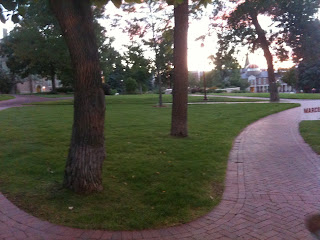In Plato’s Cave
Despite what anyone says, photography is a form of art. Unlike a painting, a photograph is an artifact with no faults or alterations. Paintings, drawings, and sculptures may be noticed as a form of history, but is everything in that work of art exactly proportional and realistic? A historic photograph on the other hand will always be the truth. When taking a picture, there is no way to change the outcome unless the lighting or the camera angle is altered. Either way, a photo will always be the exact representation of what really was in front of the camera.
Plato’s Cave is an allegory where reality is created by man’s imagination. As prisoners were tied up by their necks and legs, allowing them no movement, a fire burned behind them. A high wall stretched in front of the fire and behind the prisoners, casting the shadows of the subjects upon the cave’s wall. These prisoners could only imagine what these subjects looked like until they were freed and were able to see reality, though some of them were not freed. To these prisoners, the truth was nothing but what they were able to see on the cave’s wall.
Perceiving the world this way was nowhere near truth or reality. The shadows of the subjects casted on the walls were only an outline of what may have been a person or animal. But by believing that these shadows were replicas of the subjects only made reality more exciting. Any shadow is only, and will always be, one color. The image will always be proportionally larger than the subject and there will be nothing but an outline; no details will be involved. So these people had no rights to what features each shadow really had, they were only able to envision a large dark outline. Only to a blind man would this be considered seeing.
A photograph is a paused segment of time featured on photo paper. There are infinite pictures in the world to be taken, and each picture has infinite opinions from the public. Historical photographs: these are ways viewers can see the past, but is everything they see real? There is no way to forge a photograph, but what about the story behind it? Some pictures can make a person completely biased towards a story or myth in history. Why? Because there are no words to explain the frozen subjects or actions, so one’s opinion is less likely to change unless another photograph is more powerful.
What else are photographs used for? Photo albums are special keepsakes to a family because they may include the last memories they had with a relative or friend. They also may include photos from a family vacation just so the special trip is never forgotten. Along with vacations, many photographers travel the world to show people, who do not have the ability to travel, what the rest of the world looks like and what is going on in other places around the globe. While traveling, most of the time people will take pictures of what appeals to them and what they find interesting, unique, remarkable, or beautiful in some way. To a percentage of the viewers, the same image will emotionally appeal to them in a special way, just as it did to the photographer.
The first picture of a baby when he or she is born, his or her first steps, as a toddler, the first day pre-school, elementary school, middle school, high school, graduation day, college, college graduation, wedding day- all of these pictures are important to a person if they want to look back on their past. Taking pictures of ones self shows growth and how that person physically changes over the year, and it is always interesting to look back on those photos.
Framed, published, or printed, a picture is only one viewers perception of what was in front of the camera- the photographer’s. He or she is the only one able to understand the picture completely because no one else experienced the evidence the way he or she did. Each other viewer of the work of art will, without a doubt, create some sort of opinionated response to the picture, may it be fair or negative. A person will always believe what they see versus what they hear. In this case, a photograph will be more emotionally appealing than writing because of the lasting visual image they will have in their minds.
Printed material, like magazines or newspapers, can spread a story very quickly, but it is more likely that a person will even start to read an article if there is a picture attached beside the facts.
A photograph overpowers television because the viewer is able to create his or her own story behind the picture. In television, a story is told with footage to follow, leaving no room for one’s imagination to wonder what is going on. Also, in news, a selection of video footage may be cut out of a segment, changing the storyline. Is it possible to cut parts of a photograph without ruining the image? The vividness of a photograph will never be changed as much as video footage because there is only one piece to a photo.
Photography is one of the many arts, but it is the only one that will always be completely true an honest about what the work of art is about.






































